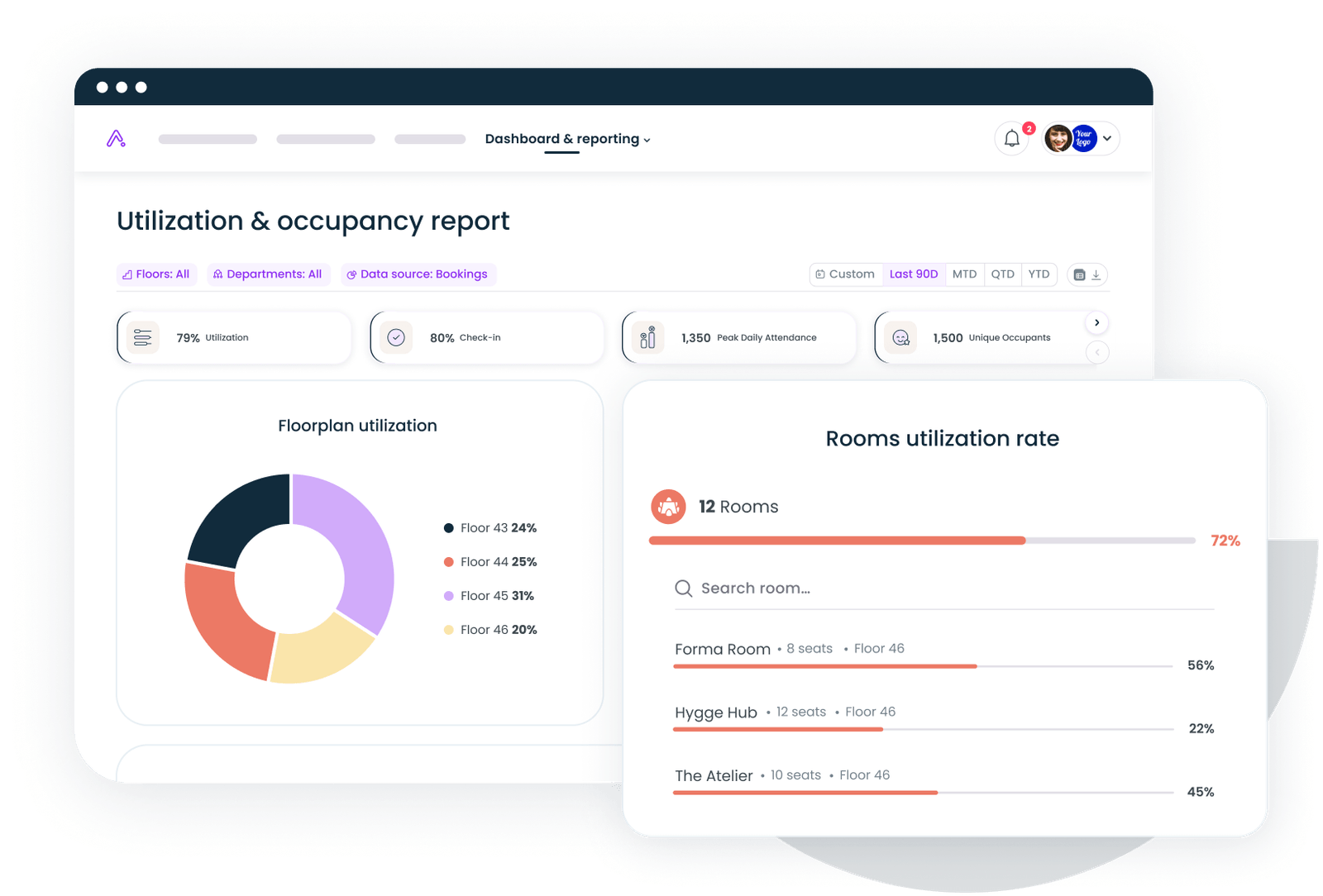Webinar Recap: Key Takeaways from Industry Leaders at Fetch and Sanofi, from a webinar held on Oct 16, 2025.
Coffee machines that increase collaboration by 17%. Automated Slack messages that welcome employees back to offices they haven't visited in months. Building systems that adjust temperature based on actual room usage, not just bookings.
These are real strategies being implemented right now by workplace leaders who've moved beyond gut feelings to data-driven decisions.
In our recent webinar, we sat down with Andrea Diieso, Director of Workplace Experience & Operations at Fetch, and William Lythgoe from Sanofi's Workplace Transformation team to explore how they're using AI and data to redefine what's possible in workplace strategy.
Building Remote-First with Intention, Not Just Policy
Andrea opened the conversation by clarifying what "remote-first" actually means at Fetch, a company with over 1,000 employees and 6 regional hubs.
"We're focusing on flexibility with purpose," Andrea explained. "We want in-person connection to be impactful and meaningful, not just coming in because the office exists. We think of our spaces as regional hubs—gathering spots where the experience really matters."
The data strategy behind it: Fetch gathers both quantitative and qualitative data across every touchpoint. They track office utilization and peak times, but also employee recognition, kudos, and engagement surveys to understand the full picture.
"You can't just look at utilization numbers," Andrea emphasized. "You have to combine that with the way people are feeling about the space. The qualitative and quantitative together give you real answers."
Even without perfect infrastructure—Fetch is still working toward universal badging systems and utilization sensors—Andrea's team creatively gathers data from every available source, including landlord access reports, travel bookings, and internal recognition programs.
Key takeaway: You don't need perfect data to make data-informed decisions. Start with what you have, track trends over time, and build your strategy incrementally.
The Surprising Metrics That Drive Collaboration
William's team at Sanofi discovered something unexpected while analyzing their newly redesigned spaces: upgrading coffee machines correlated with a 70% increase in spontaneous collaboration.
"We weren't looking for that," William admitted. "We started with the obvious metrics—utilization rates, occupancy patterns, space flows. Then we started cross-referencing data points. Sometimes correlations make sense and you dig deeper. Eventually, you find something meaningful."
The coffee discovery led to broader insights about furniture arrangement, space design, and how employees actually use spaces versus how designers intended them to be used.
The lesson: Keep an open mind when analyzing workplace data. The most valuable insights often come from unexpected connections between different data sources.
William's team now correlates sensor data with food ordering patterns, environmental controls, and even occupational health metrics to understand the full employee experience.
Change Management at Scale: Moving 800 Scientists Into One Building
When Sanofi consolidated 800 scientists from 9 different sites across 3 cities into one new building, William's team faced a masterclass in change management.
His approach? Make the data personal and relevant.
"Scientists are quite resistant to change—or more accurately, they're very resistant to uninformed change," William explained. "Involve them ahead of time. Use data to listen, not just convince. Show them their current baseline, then show where you're going."
The communication strategy:
- Lay out the process like a scientific experiment so they understand what's happening and when
- Communicate early, consistently, and frequently across multiple channels
- Use local change champions and managers to reinforce messaging
- Share results transparently and adapt based on feedback
"You can almost never over-communicate during change," William noted. "If there's too little communication, that's when people get nervous."
AI Implementation Without Massive Budgets
Both speakers emphasized that effective AI implementation doesn't require unlimited resources.
Andrea's company dedicates company-wide time to AI innovation—they ran an AI Hack Week that produced over 200 projects in three and a half days, and now every Friday afternoon is dedicated to AI exploration.
Practical AI implementations at Fetch:
- Automated onboarding/offboarding workflows that pull access data and notify the right team members
- Travel-triggered notifications that offer office access and information when employees book trips near regional hubs
- Recognition systems that scale connection without manual intervention
"A lot of the tools we already use are coming out with AI-enabled workflows," Andrea explained. "Start looking into what your existing platforms offer—Google's Gemini, workplace experience apps with AI integrations, project management tools. You don't have to convince anyone to spend more money."
William's approach at Sanofi:The team integrates sensor data with AI-powered building management systems to create proactive rather than reactive environments. Instead of waiting for a conference room to get stuffy and then pumping in fresh air, sensors detect occupancy and adjust air quality preemptively.
The business case? ROI, energy savings, reduced facilities tickets, and certification benefits (LEED, wellness certifications).
"When talking to finance, it's about payback period and energy savings," William said. "As long as you can prove that in an easy-to-read document, you're usually okay."
Balancing Innovation with Scale
Both leaders manage large, complex organizations—Fetch with 6 offices and 1,000+ employees, Sanofi with 250+ sites and over 80,000 employees. How do they innovate without creating chaos?
Andrea's framework:
- Start small and grow from there
- Determine what must be consistent versus what can have local flexibility
- Communicate early to get stakeholder buy-in
- When things don't work, you've already built trust for the iteration
William's approach:
- Optimize the process first before adding technology
- Pilot fast and fail fast
- Balance innovation with stability to avoid change fatigue
- Keep some things the same when implementing big changes
"If you're moving into a new building, maybe don't change everything at once," William advised. "Let people settle, then move forward. Otherwise it's always a bumpy road."
The Future: Agentic AI and Personalized Workspaces
When asked what they'd implement with unlimited budget and time, both speakers painted compelling visions.
Andrea envisions agentic AI that handles all the "operational noise"—proactively managing scheduling, follow-ups, data organization, and event logistics so workplace teams can focus on human connection and strategic impact.
William imagines personalized workspaces where AI knows your preferences and handles everything automatically: books your parking spot, reserves a desk next to collaborators based on your email patterns, orders your preferred lunch, adjusts room temperature to your preference, and optimizes the entire workplace experience.
"The workplace should work for you instead of you trying to adapt to the workplace," William said.
Key Takeaways for Workplace Leaders
Start with imperfect data. You don't need sensors and advanced systems to make data-informed decisions. Use what you have—landlord reports, travel bookings, employee surveys—and track trends over time.
Combine qualitative and quantitative metrics. Utilization numbers only tell part of the story. Employee sentiment, recognition data, and feedback complete the picture.
Over-communicate during change. Use multiple channels, involve local champions, and share both successes and failures transparently.
Leverage existing AI tools first. Before requesting new budget, explore AI capabilities in your current platforms—workplace apps, project management tools, Google Workspace, Microsoft 365.
Balance innovation with consistency. Determine what needs to be standardized versus what can have local flexibility. Pilot quickly, fail fast, and avoid change fatigue by giving people time to adapt.
Look for unexpected correlations. The most valuable workplace insights often come from cross-referencing different data sources and staying open to surprising connections.
The workplace leaders who are succeeding aren't waiting for perfect conditions. They're experimenting with available tools, gathering imperfect data, and iterating quickly based on what they learn.
You're not alone if you're making workplace decisions that feel like educated guesses. But with the frameworks and examples shared by Andrea and William, you can start moving from guesswork to genuinely smart decisions—one data point, one pilot, one iteration at a time.

Get a demo and see how Gable helps companies optimize their hybrid, remote, and in-office experience, save money on real estate, and make data-driven decisions.
Get a demo





.svg)





.svg)
















.svg)














